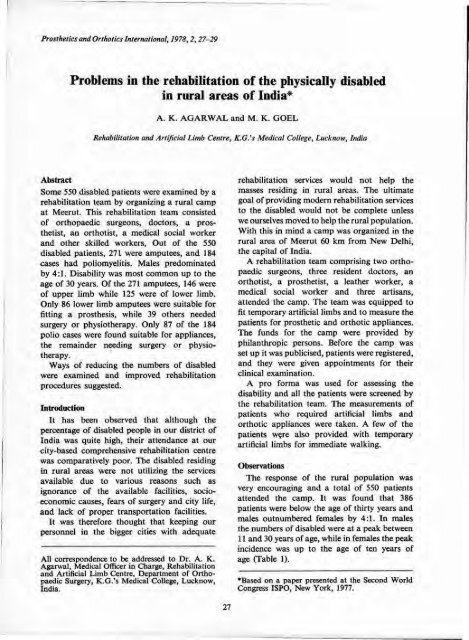Prosthetics and Orthotics
Prosthetics and Orthotics
Prosthetics and Orthotics
Create successful ePaper yourself
Turn your PDF publications into a flip-book with our unique Google optimized e-Paper software.
Abstract<br />
Problems in the rehabilitation of the physically disabled<br />
in rural areas of India*<br />
A. K. AGARWAL <strong>and</strong> M. K. GOEL<br />
Rehabilitation <strong>and</strong> Artificial Limb Centre, K.G.'s Medical College, Lucknow, India<br />
Some 550 disabled patients were examined by a<br />
rehabilitation team by organizing a rural camp<br />
at Meerut. This rehabilitation team consisted<br />
of orthopaedic surgeons, doctors, a prosthetist,<br />
an orthotist, a medical social worker<br />
<strong>and</strong> other skilled workers, Out of the 550<br />
disabled patients, 271, were amputees, <strong>and</strong> 184<br />
cases had poliomyelitis. Males predominated<br />
by 4:1. Disability was most common up to the<br />
age of 30 years. Of the 271 amputees, 146 were<br />
of upper limb while 125 were of lower limb.<br />
Only 86 lower limb amputees were suitable for<br />
fitting a prosthesis, while 39 others needed<br />
surgery or physiotherapy. Only 87 of the 184<br />
polio cases were found suitable for appliances,<br />
the remainder needing surgery or physiotherapy.<br />
Ways of reducing the numbers of disabled<br />
were examined <strong>and</strong> improved rehabilitation<br />
procedures suggested.<br />
Introduction<br />
It has been observed that although the<br />
percentage of disabled people in our district of<br />
India was quite high, their attendance at our<br />
city-based comprehensive rehabilitation centre<br />
was comparatively poor. The disabled residing<br />
in rural areas were not utilizing the services<br />
available due to various reasons such as<br />
ignorance of the available facilities, socioeconomic<br />
causes, fears of surgery <strong>and</strong> city life,<br />
<strong>and</strong> lack of proper transportation facilities.<br />
It was therefore thought that keeping our<br />
personnel in the bigger cities with adequate<br />
rehabilitation services would not help the<br />
masses residing in rural areas. The ultimate<br />
goal of providing modern rehabilitation services<br />
to the disabled would not be complete unless<br />
we ourselves moved to help the rural population.<br />
With this in mind a camp was organized in the<br />
rural area of Meerut 60 km from New Delhi,<br />
the capital of India.<br />
A rehabilitation team comprising two orthopaedic<br />
surgeons, three resident doctors, an<br />
orthotist, a prosthetist, a leather worker, a<br />
medical social worker <strong>and</strong> three artisans,<br />
attended the camp. The team was equipped to<br />
fit temporary artificial limbs <strong>and</strong> to measure the<br />
patients for prosthetic <strong>and</strong> orthotic appliances.<br />
The funds for the camp were provided by<br />
philanthropic persons. Before the camp was<br />
set up it was publicised, patients were registered,<br />
<strong>and</strong> they were given appointments for their<br />
clinical examination.<br />
A pro forma was used for assessing the<br />
disability <strong>and</strong> all the patients were screened by<br />
the rehabilitation team. The measurements of<br />
patients who required artificial limbs <strong>and</strong><br />
orthotic appliances were taken. A few of the<br />
patients wçre also provided with temporary<br />
artificial limbs for immediate walking.<br />
Observations<br />
The response of the rural population was<br />
very encouraging <strong>and</strong> a total of 550 patients<br />
attended the camp. It was found that 386<br />
patients were below the age of thirty years <strong>and</strong><br />
males outnumbered females by 4:1. In males<br />
the numbers of disabled were at a peak between<br />
11 <strong>and</strong> 30 years of age, while in females the peak<br />
incidence was up to the age of ten years of<br />
age (Table 1).<br />
*Based on a paper presented at the Second World<br />
Congress ISPO, New York, 1977.

















